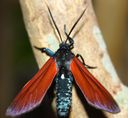Hodges#8272
Empyreuma pugione
Classification
- Phylum: Arthropoda
- Subphylum: Hexapoda
- Class: Insecta
- Order: Lepidoptera
- Superfamily: Noctuoidea
- Family: Erebidae
- Subfamily: Arctiinae
- Tribe: Arctiini
- Subtribe: Euchromiina
- Genus: Empyreuma
- Species: pugione
Pronunciation
How to pronounce Empyreuma pugione: /ɛmˌpɪəˈruːmə pjuːˈɡioʊni/
These audio files are automatically generated. While they are not always 100% accurate, they are a good starting point.
Images





Summary
Empyreuma pugione, known as the spotted oleander caterpillar moth, is a day-flying moth found in Coastal Southern Florida and the West Indies, feeding primarily on Nerium oleander. It has a notable appearance with a wingspan of 43–48 mm and features a light orange, hairy caterpillar stage.
Physical Characteristics
Wingspan is 43–48 mm; larvae are light orange and hairy.
Identification Tips
Look for the distinctive light orange and hairy larvae; adults have a characteristic appearance related to the Arctiinae subfamily.
Habitat
Coastal Southern Florida and the West Indies, often associated with oleander plants.
Distribution
Primarily found in the West Indies and Coastal Southern Florida; first recorded in the US in Boca Raton, Palm Beach County, in February 1978.
Diet
Larvae feed on Nerium oleander.
Life Cycle
The life cycle includes stages from eggs to larvae (caterpillar) to cocoon to adult moth.
Reproduction
Females lay eggs, which then hatch into larvae.
Ecosystem Role
May play a role in pollination as an adult and as a herbivore during the larval stage.
Evolution
Recent immigrant species introduced from the Caribbean.
Misconceptions
Sometimes confused with other moths in the Arctiinae subfamily; the common name may cause confusion with other species associated with oleander.
Tags
- Empyreuma pugione
- spotted oleander caterpillar
- Arctiinae
- moth
- Florida